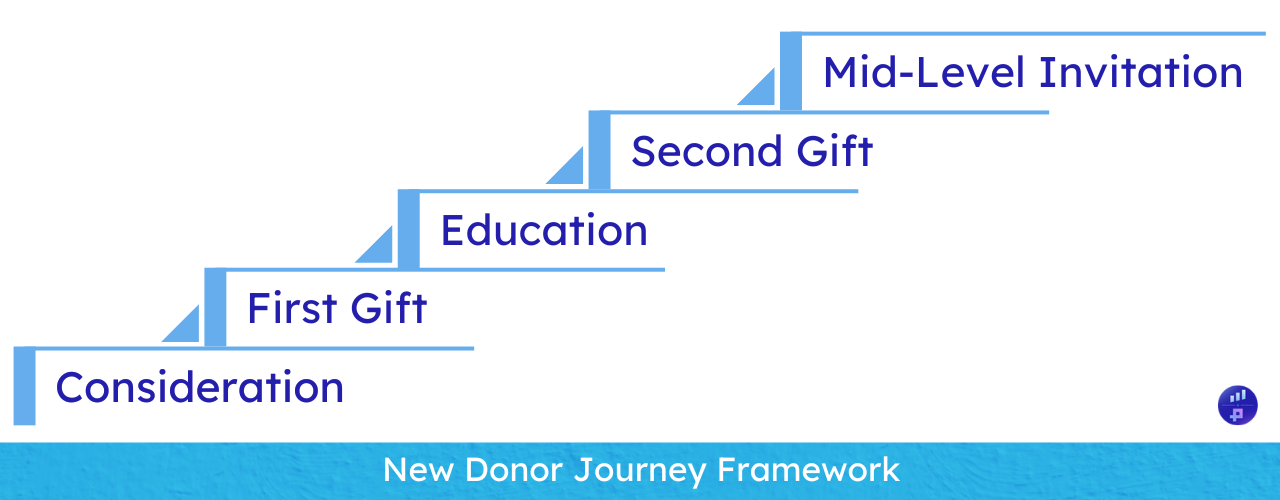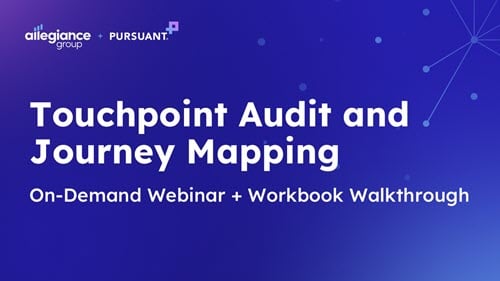Mapping Our Way to an Inclusive Donor (and Team) Experience

As fundraisers, we’re also storytellers — and every donor has a story. When we can identify what those stories are and understand the kind of path our donors follow at each stage of the giving process, we can gently guide their journey, connect with them at a deeper level, build strong relationships, and improve fundraising results.
Donor Journey Mapping is a process for helping organizations understand their current donor experience, identify opportunities to improve, and implement a plan to enhance it. While not a “quick fix” fundraising solution (meaningful change is rarely instant), it’s an excellent way to engage, upgrade, and retain your donors.
Donor Journey Mapping borrows from the for-profit sector, which has long understood the importance of customer journeys and the role this plays in creating exemplary brand experiences. Brand experience combines sensations, feelings, cognitions, and behavioral responses evoked by brand-related stimuli that are part of a brand’s design and identity, packaging, communications, and environments.
A great brand experience makes customers feel recognized, heard, and valued. Whether for-profit or nonprofit, when an organization provides an excellent experience, it deepens the connection a donor feels with their organization. This leads to increased loyalty, greater satisfaction, and a better ROI, especially compared to acquiring new donors.
An excellent donor experience:
- Makes giving easy and joyful
- Creates a great first (and second. third. and fourth) impression
- Invites additional ways to experience the brand
- Communicates impact
- Nurtures the highly involved donors
Recently, Intermountain Health undertook a two-day Donor Journey Mapping Exercise to create a strategy to engage new donors with the capacity to become mid-level donors. They knew the time was right — like many healthcare organizations, the early days of the COVID-19 pandemic brought in a new group of healthcare-aware donors that they didn’t want to lose. Their goals were to identify and refine more strategic new donor journeys to drive stronger retention, earlier upgrades, and increase the number of donors giving $1k+ annually. These potential mid-level donors were inspired to make their first gift during the extraordinary environment of the pandemic and required a distinct donor journey. If the team at Intermountain could understand the path, they would be in a better position to make it smoother and more rewarding.
“I think it’s always a challenge to really have an in-depth understanding of what our donor behaviors are and what their preferences are,” said Kathy Dalton, Annual Giving Specialist at Intermountain Health. “We knew that we had a really strong base of donors, but we really had a hard time figuring out how to effectively engage them in the ways that resonate with them at a deeper level. There wasn’t a clear picture of how the donors move through the different stages of giving and go from that first-time donor to a larger, more committed donor.”
Understand the Current Donor Experience
Before you can improve your donor experience, you have to take stock of the current one. “Donors” is a big category that’s too general and universal to approach with a single strategy.
The team at Intermountain Health used their existing donor data to identify the new donors they wanted to focus on. They did their Donor Journey Mapping Homework by:
- Defining the audience: Donors who had the potential to make a $1k gift.
- Defining the problem they were solving: Retaining and upgrading these donors more efficiently
- Determining the demographics of their audience: On review of their data, they found that their target group was primarily female, married, and over the age of 34.
Need help understanding your donors?
With a clear picture of their donors in mind, the team first mapped their current state, identifying gaps and opportunities.
“We identified some communication gaps and where those touchpoints were, and we tracked those motivations,” Dalton said. “I think a lot of us on our team are just very visual people, and it really helped to work through that with our team visually. We [discovered that we] weren’t really using our data as well as we’d hoped.”
The New Donor Journey Framework

The journey from first-time to devoted giver goes through several stages:
- Consideration: Before making a gift, the donor learns that the organization exists and that giving is possible. They consider whether they want to give. This phase can last 10 seconds or for years, but it ends when the donor decides to make their first gift.
- First Gift: The donor makes their first gift. Unfortunately, for the vast majority of givers, this is the end of the journey. [1] That’s why continuing to engage them and point them toward the next step is so important.
- Education: The donor learns more about the organization and the impact of their gift.
- Second Gift: They give again. The odds of them becoming a regular donor increase dramatically. [2]
- Mid-Level Invitation: The donor is invited to give more and is solicited and stewarded as a mid-level donor.
At each stage, the organization invites the donor to connect more, learn more, and become more committed to the cause.
What Does a Donor Journey Mapping Exercise Look Like?
Mapping a new donor journey is a group endeavor. The more cross-department collaboration you can cultivate, the better.
“Our marketing communications team, our stewardship, our data people, even some of our major gift people were part of the conversation,” Dalton said.
This helped the team at Intermountain Health create a shared vision for the future state of their new donor journey.
The Current State and Target Group
The Donor Journey Mapping Exercise begins with describing the current state and identifying the particular donor population you’re trying to engage.
Goals, Touchpoints, and Feelings
Then, the team begins to imagine a future donor journey together. They describe the goals and touchpoints for donors at each stage of the journey and the feelings associated with each stage.
For example, during the education phase, you may want the donor to learn specific things about the impact of their gift. The touchpoints could include an impact report, an email update, or a video. The associated feelings might be curiosity, inspiration, or satisfaction.
These ideas are all added to a sticky note mural of the journey framework (you can physically create one with actual sticky notes or use a digital tool) for consideration. Once the mural is complete, participants can identify opportunities to provide new donors with an exceptional brand experience.
As you look at all your donors’ touchpoints and experiences, look for where you’re delighting them. Do you send a popular holiday card? Call just to say thank you? Share inspiring videos?
On the flip side, you should also look for the spots in the journey where you may be disappointing your donors. Does every email start with “Dear Friend” instead of their name? Do they go a long time without hearing from you after they give? Does every communication you send them contain an ask? Are there inconsistencies in brand look, feel, and messaging?
Evaluating Opportunities
At this point, you might find yourself either buzzing with excitement or completely overwhelmed with all the opportunities your team has identified. The evaluation section of the exercise will help you choose which opportunities to implement and which to set aside.
Each opportunity is plotted on a matrix with an axis of the organization’s ability to implement the opportunity and another axis of how much impact the opportunity is likely to have. This will divide the opportunities into four categories:
High impact/highly able to implement = No brainers
These are improvements that will require little to no effort to complete.
High impact/low ability to implement = Transformative
These represent a marked improvement in operations that positively impact your fundraising but that will be harder to implement.
Low impact/highly able to implement = Quick wins
These are simple and swift changes to improve fundraising performance.
Low impact/low ability to implement = Derailers
These efforts will cause fundraising to deflect from its purpose or direction.
Watch our Touchpoint Audit and Journey Mapping webinar and download a free copy of Journey Mapping Workbook: A Guide for Deepening Relationships with Your Constituents to help your team succeed.
Moments of Truth and Committing to a Plan
If you approach the evaluation phase with stringent honesty about your capacity and the potential for impact, you’ll uncover powerful moments of truth that can reveal how to prioritize your fundraising activities in the new donor journey.
Once you’ve determined your transformative, no-brainer, and quick-win opportunities (and discarded all derailers), it’s time to build a plan. Create a section for each kind of opportunity and identify which pain points it will solve, which department will own the effort, and which staff members or leadership will serve as champions.
If you still find your Donor Journey Plan a bit overwhelming, consider further prioritizing by assigning a 1-5 scale of effort and impact to help track the weight of the “lift” on each strategy or tactic.
This document will be the basis of your plan. As you proceed, you can add timelines and logistics for implementing it and establish methods for ongoing collaboration.
Intermountain Health’s Donor Journey Mapping Journey
With a better picture of their current state, gaps, and all, the team at Intermountain Health brainstormed their future new donor journey, creating many potential opportunities.
Together, they identified transformative opportunities, like partnering with more of their caregivers in storytelling, streamlining the operations of mid-level gift officers, communicating program impact more, and personalizing stewardship. They settled on some quick wins, like segmenting their communications, eliminating the use of “Dear Friend,” and implementing a new donor welcome series. They found no-brainers, like aligning how they talk about the role of the donor across departments and creating new brand awareness.
Donor Journey Mapping helped the team at Intermountain Health quickly transition from feeling that they were leaving money on the table to a concrete, mutually agreed-upon plan to engage and upgrade a specific set of donors. Perhaps even more importantly, they laid the groundwork for a new collaboration practice.
“I think for me to have everybody in the same room and part of the solution was as valuable as the actual Donor Journey Mapping process because it created a baseline for us all to start from and to see that we are all on the same team,” Dalton said.
Cross-departmental collaboration gave everyone a deeper understanding of each department’s work, expanding understanding and eliminating some existing tensions and misconceptions.
Tell the Story Together
Donor Journey Mapping is a starting point that allows fundraising and development teams to work together to understand their donors and create more opportunities to connect with them. As time goes on, you’ll learn more, receive donor feedback, and be able to continually refine and revise the touchpoints and goals for each type of donor.
An outside eye can be a valuable asset in this process. It can be challenging to identify all the places where you’re delighting or disappointing donors and a donor-focused agency can be an important partner in this work.
When you dig deep into your donor journey, identify opportunities to delight them, accurately assess your impact, determine your organizational capacity, and make a new plan with your whole team; the journey becomes more meaningful and valuable—not just for your donors but also for you.
Let our experts help you with your Donor Journey Mapping
Jessica Woodard, AVP, Client Strategy at Allegiance Group + Pursuant
Jessica Woodard brings over a decade of expertise in nonprofit fundraising to her role at Allegiance Group + Pursuant, where she is dedicated to the success of hospital foundations. As a strategic leader, she specializes in creating integrated direct-response fundraising plans that deliver measurable outcomes. Her strong communication skills, friendly demeanor, and exceptional organizational abilities allow her to collaborate effectively with clients to achieve their goals. Since joining the agency in 2012, Jessica has played an integral role in elevating the fundraising success of numerous healthcare organizations.
Kristin Priest, MA, CFRE, VP, Client Strategy at Allegiance Group + Pursuant
Kristin Priest, MA, CFRE, brings over two decades of consultancy and fundraising expertise to her role as VP of Client Strategy. She specializes in enhancing nonprofit development programs through major giving, capital campaigns, capacity building, and data analytics. Kristin is committed to strengthening the nonprofit community and serves on the Milton Murray Fund board, is a member of AFP’s Research Council, and is a founding member of the Fundraising Effectiveness Project. With a master’s in Philanthropic Studies from the Lilly Family School of Philanthropy, she holds the CFRE designation. She has extensive experience as both a mid-level and major gift officer.
Kathy Dalton, Annual Giving Specialist at Intermountain Health
Kathy Dalton draws on more than 20 years of experience in marketing communications, social networking, and new business development in her role as Annual Giving Specialist at Intermountain Healthcare Foundation, one of the nation’s leading not-for-profit healthcare systems. She is passionate about inspiring donors, volunteers, and partners to support the foundation’s mission of helping people live the healthiest lives possible. Kathy specializes in crafting compelling storytelling, curating impactful social media strategies, and developing high-impact campaigns that drive engagement and support the growth of the foundation’s brand across key channels.
[1] “Quarterly Fundraising Report.” FEP 2024 Quarterly Benchmark Report. Accessed September 9, 2024. https://data.givingtuesday.org/fep-report/.
[2] Jacobs, Bill. “The Exponential Importance of Second Gift Timing: Analytical OnesTM.” Analytical OnesTM | Data Your Donors Will Love, July 3, 2020. https://www.analyticalones.com/the-exponential-importance-of-second-gift-timing/.
